Earlier in the year our team here at Koozai was told that Google would start hiding some of the search query data that was previously visible in the search terms report section of Google Ads. More on this can be found here. As an experienced PPC Agency, we thought it vital to test out this theory in order to inform and improve our client campaigns. In summary, Google said that they would stop showing us search terms that had been clicked, but were not searched on by a significant number of people. This was introduced in September and we now have a few months’ data to check back to see what impact it has had.
Our results have been analysed by looking at the ‘Search Terms’ report in Google Ads. We looked back at 6 months worth of data (June-November inclusive) and applied a segment for the month. This provides us with 3 months before and 3 months since the change in search term reporting. The main area to look at in your Google Ads account to see this information is right at the bottom of the search terms report where we see the ‘Totals’. We have compared the ‘Total: Search terms’ with the ‘Total: Omitted search terms’ (or ‘Total: Other search terms’). This essentially compares metrics where the search term has been recorded vs the metrics where the search term has been hidden.
We have looked at this for a number of accounts to check for consistency in our results and we will be comparing results from 3 clients.
Client A – a customer services client
Client B – a legal firm
Client C – a healthcare brand
Client C has lower volume so the results are slightly different from A & B, but this gives a broader spectrum of results. Below, we assess the impact the move to limit the visibility on search query data has had on key metrics.
Clicks
The shift in the number of clicks being driven through omitted search terms has been massive. Client A and B were driving between 1-2% of clicks through omitted search terms before September and client C was driving between 3-13%.
Since September, the omitted search terms clicks have gone through the roof, with a minimum of a quarter of clicks now being recorded as omitted search terms and even as high as 54% on client C. This means that we now have little idea which terms users are searching for in over half of our clicks!
Historically, we would have visibility on the majority of clicks being driven by our account and we would run search term reports to either add search terms as keywords or negate irrelevant ones from triggering our ads to show. Now, we have lost a lot of visibility as Google is no longer showing us the terms that are triggering our ads to show in 24%-54% of cases.
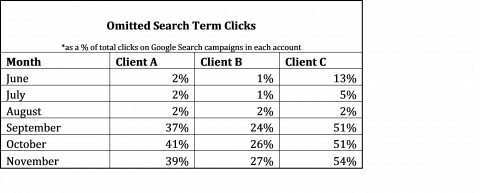
Spend
This of course is going to have an impact on spend. This matters a great deal to us as we have now lost visibility and control over a large proportion of our PPC spend. Beforehand we could attribute over 97% of spend to a search term on client A and B, but since the changeover in September, this has dropped to between 58%-76%. On client C, we can attribute between 32%-45% of spend to search terms, with the majority of spend driving search terms becoming invisible.
CPCs are also generally higher on the omitted search terms. Client B is the worst affected by this and is seeing 25% higher CPCs on the omitted search terms. In October, their omitted search term CPCs were 50% higher than recorded search term CPCs. Paired with an increase in omitted search term clicks, the spend through omitted search terms is increasing at an alarming rate.

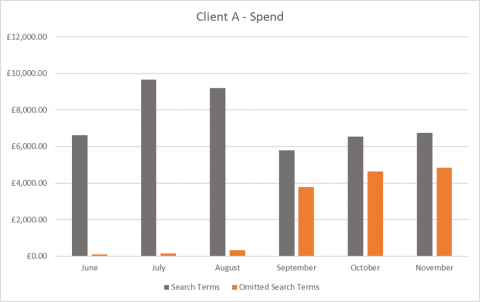
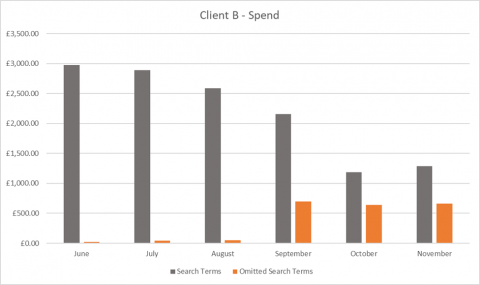
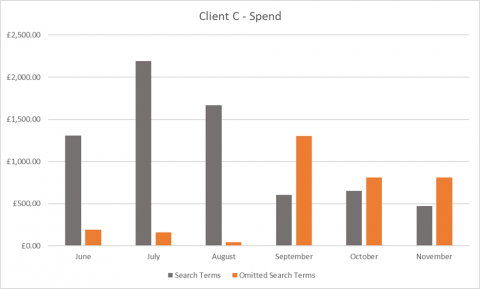
Conversions
As with clicks and spend, conversions have also seen an increase through omitted search terms. This, of course, is good news because it shows that although we can’t see the search terms that have been omitted, they are still converting. But it raises the question – why can’t Google show us the terms that are being clicked on and converting?
Before the implementation of this, we would be able to add these converting search terms as exact match keywords into the account. This would provide better control over bid management and would typically result in cheaper CPCs and better conversion rates through the keyword. Now that these converting omitted search terms are hidden from us, there is nothing that we can do with them. The table below shows that all 3 clients have seen a large increase in the conversions being recorded through omitted search terms.
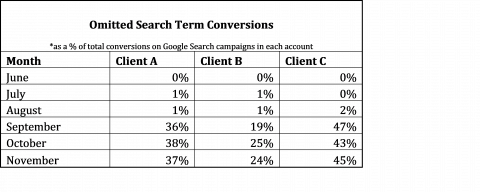
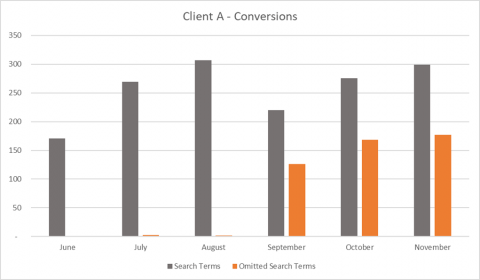
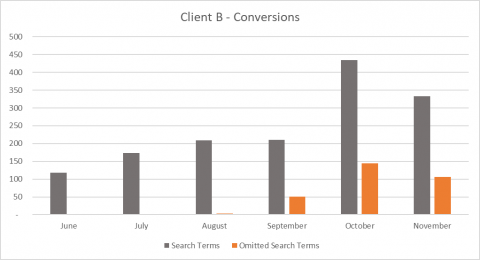
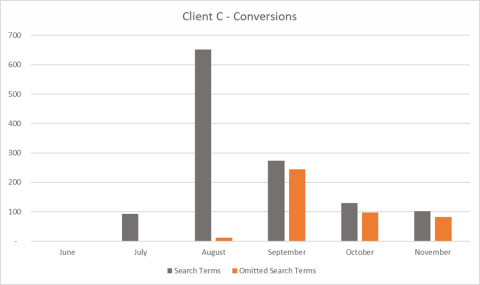
Whilst we know that conversions have increased through omitted search terms, the conversion rate on them is much lower than the recorded search term conversion rate. This is because, we can’t see what is being triggered, therefore we can’t negate any irrelevant queries that are draining our budget and impacting our conversion rate. As more traffic and spend is driven through these omitted search terms, paired with the inability to optimise and manage these queries, we will continue to see poorer conversion rates and higher CPAs.
Summary & next steps
In summary, the changes that Google has implemented are bad news for PPC managers. As we have seen from the data above, we have lost a lot of visibility on the search terms that are triggering our ads to show. In some cases, half of the traffic that is being driven through our PPC account is invisible to us and we need to trust that Google is spending the budget in the right way. Not only this but in some cases up to 70% of spend is being spent through these omitted search terms, meaning that we do not know where £7 in every £10 is being spent.
If Google doesn’t reverse this, the future of paid search as we currently know it is worrying. We will continue to lose visibility and control over users’ search terms and we will no longer be able to build out accounts in the way that we have for many years. Furthermore, we’ll continue to lose visibility on irrelevant search terms and we won’t be able to negate these to save our budget.
PPC managers will have to adapt to this change, but with a lack of visibility on the omitted search terms, what can we do? One option is to build thorough negative keyword lists from the keyword planner. Run keyword research using the Google keyword planner, specifically looking at queries that would trigger your ads to show but may not be recorded as search terms. Queries that you would not want to appear for, build out in a negative list, and apply it to the campaigns and ad groups. Essentially, we’re trying to pre-empt any queries which may be categorised as omitted and doing what we would normally do in a usual search term report.
Having said this, it seems like this is the next step as Google prepares us for keyword-less paid search. We’ve already seen the introduction of Smart Campaigns and Google has recently recommended that we give broad match keywords another shot. It appears that Google wants us to trust their algorithm more, use smart bidding strategies and let them find the most relevant users for us based on their browsing habits and behaviours.
Only time will tell what the future of PPC looks like, but this update is certainly a move towards keyword-less search and trusting Google’s algorithm.

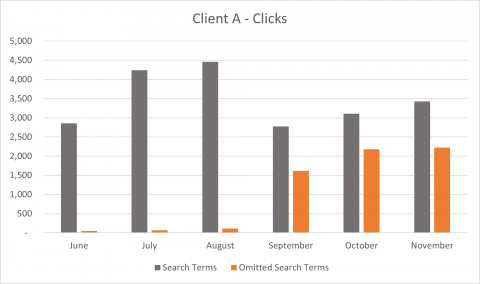
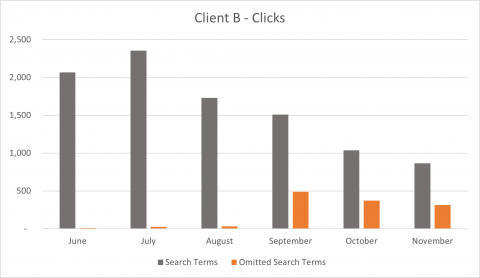
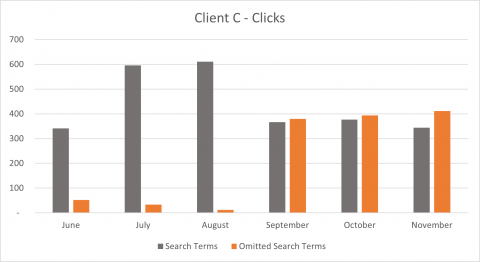

Leave a Reply